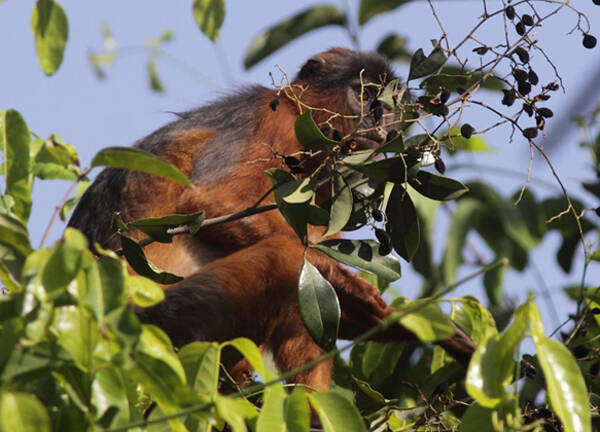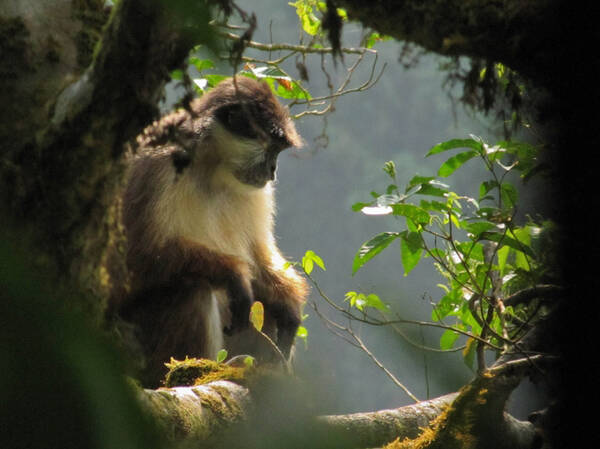Procolobus pennantii
IUCN
LCBasic Information
Scientific classification
- name:Procolobus pennantii
- Scientific Name:Procolobus pennantii,Bioko Red Colobus,Oko Red Colobus
- Outline:Primates
- Family:Cercopithecidae R.Colobus
Vital signs
- length:53-63cm
- Weight:7-11kg
- lifetime:No verification information
Feature
The head is black, the back, limbs and other parts are brown-red or chestnut-brown, and the chest and abdomen are grayish white
Distribution and Habitat
Distribution: Equatorial Guinea (Biok Island). The species is arboreal and spends most of its life in the treetops. It can be found at all levels of the canopy in primary and secondary rainforests. The occurrence of monkeys of the genus Red Colobus is higher in density in primary forests than other colobus species. Pennant Red Colobus also lives in swamp forests, dry forests. Usually, this species is found at relatively high altitudes.
Appearance
The Pennant's Red Colobus has a slender body, with a head-body length of 53-63 cm, a tail length of 60-70 cm, and a weight of 7-11 kg. It has a typical small head, a long back, and a rounded abdomen. The limbs are very long. Like other colobus species, the anal warts are small, the tail is long, and the cheek pouches are smaller than those of ordinary monkeys. The fingers are particularly long, and the slender fingers are clenched back to form a strong hook, which is suitable for grasping branches. One of the most notable features of the colobus is the lack of a thumb. There is still a bump where the thumb should remain, making it look as if the thumb has been cut off. In this species, like other African colobus species, the thumb has degenerated into a small wart. The fur color of the Pennant's Red Colobus is black on the head, brown-red or chestnut-brown on the back, limbs and other parts, and gray-white on the chest and abdomen. The hair on the forehead is typically parted
Details
Pennant's Red Colobus (scientific name: Procolobus pennantii) is also known as Bioko Red Colobus, and has no subspecies.

The family territory of the Pennant's Red Colobus can extend to 100 hectares or more, often overlapping with the territories of other groups. Diurnal. They are arboreal and usually live in groups of dozens or hundreds of individuals. Like other red colobus species, groups are multi-male and multi-female, with a high proportion of females, even twice as many as males. They move quickly between trees, moving through the woods on all fours, sometimes using slender branches to bounce and jump through gaps in the canopy. Females usually live in the same group, but males often move to new groups several times in their lives and may also form same-sex groups. Although larger groups occasionally occupy the territory of smaller groups when competing for food, the species generally does not have a strong sense of territory.
Pennant red colobus monkeys are social animals that communicate or connect in three ways. The first is social display, in which the displayer points its rear toward the recipient and raises its hind legs above the rest of the body. All males except adult males will succumb to this behavior. The second is social grooming, where they use their mouths to remove unwanted material from each other, such as dead skin, insects, or parasites. Although this behavior is important in terms of hygiene, its real purpose is to strengthen the bond between each other. The third form of social interaction is language or sound, which is loud. Noises described as "barking" and "squeaking" can be very important auditory communication between individuals and between groups.
The Pennant Red Colobus forages for food in the upper layers of the forest, tending to feed in the morning and evening. It is completely vegetarian. Their diet consists of immature leaves and shoots, as well as seeds and fruits. The colobus has a complex stomach structure and a strong digestive capacity, which allows it to break down difficult-to-digest plants such as cellulose. Large amounts of plant matter enter the stomach every day, and during this fermentation process, ripe sugary fruits produce excessive amounts of gas and acid when consumed. This causes pain and can lead to death. Therefore, this species can only digest immature and tough fruits. They also eat mosses, seeds and fungi, and will even eat termite clay and charcoal to help digest toxins on leaves.

Little is known about the reproduction of the Pennant's red colobus monkey, although it is likely similar to other species in the subfamily Colobinae. The female's genital area swells during estrus. Females use "social displays" to indicate that they are ready to mate. Colobus monkeys reproduce in a "communal marriage" style, where females are ready to mate and males withdraw from the larger group. Colobus monkeys are polygamous, meaning that for every male's mating, multiple females are involved. Colobus monkeys do not have a specific breeding season, with females giving birth approximately every two years. Pennant's red colobus monkeys give birth to one offspring at a time. The gestation period for this particular species is unknown, but other colobus monkeys have a gestation period of 5-7 months. After pregnancy, female colobus monkeys leave the group accompanied by a single male and do not return until the day after giving birth. In Africa, female colobus monkeys usually reach sexual maturity between 3-4 years of age, while males reach sexual maturity between 5-6 years of age. For the first 1-3.5 months after birth, the mother is usually the only one to raise the young. After this, other group members will help care for the young. Both male and female subadults have reproductive area features similar to those of adult females. This is thought to protect the immature male subadults from being expelled from the group by adult males.
The main threats to the Pennant's Red Colobus are hunting and habitat degradation. The Pennant's Red Colobus is listed as critically endangered because the species has a very limited range on Bioko Island, approximately only 160 square kilometers, and the species population is suspected to have declined by more than 80% in the past three generations (1986-2016), mainly due to heavy hunting in the limited range. In addition, chimpanzees are common predators of the Pennant's Red Colobus and can reduce the population by up to 10% per year.
The Pennant's Red Colobus enjoys some protection under the Republic of Equatorial Guinea and international legislation. Its population is entirely within legally recognized protected areas, and hunting is prohibited. In addition, a Guinean presidential decree of October 2007 prohibits the hunting, sale and consumption of all primates. However, there is no management plan for the "Crater Grande Scientific Reserve". The Pennant's Red Colobus Monkey enjoys some protection under the Republic of Equatorial Guinea and international legislation. Its species population is entirely within a legally recognized protected area, where hunting is prohibited. In addition, a Guinean presidential decree of October 2007 prohibits the hunting, sale and consumption of all primates. However, there is no management plan for the "Crater Grande Scientific Reserve".
Listed in the "IUCN Red List of Threatened Species" 2016 ver 3.1 - Critically Endangered (CR).
Listed in the "CITES" Appendix II protected animals.
Listed in Category B of the African Convention for the Conservation of Nature and Natural Resources.
Protect wildlife and eliminate game.
Maintaining ecological balance is everyone's responsibility!








